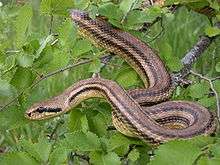Four-lined snake
| Four-lined snake | |
|---|---|
 | |
| Scientific classification | |
| Kingdom: | Animalia |
| Phylum: | Chordata |
| Class: | Reptilia |
| Order: | Squamata |
| Suborder: | Serpentes |
| Family: | Colubridae |
| Genus: | Elaphe |
| Species: | E. quatuorlineata |
| Binomial name | |
| Elaphe quatuorlineata (Lacépède, 1789) | |
 | |
| Synonyms | |
| |
Elaphe quatuorlineata (common names: four-lined snake, Bulgarian ratsnake[3]) is a member of the family Colubridae.[4] The four-lined snake is a non-venomous species and one of the largest in the Colubridae.[5]
Description
The species' common name refers to the markings seen on the body of adult snakes: four dark stripes running along a yellowish brown body.[5] Juveniles, by contrast, have a dorsal series of dark brown blotches with alternating dark brown spots on the sides, all on a pale brown background.[3] A black line runs from the corner of the eye and the belly is cream to white with darker markings.[6] Adults can reach a length of 180 cm, rarely 200 cm.[7]
Distribution
Four-lined snake is found in Italy, along the whole western coast of the Balkan peninsula, in the western half of Greece and many of the Greek islands, Macedonia (region), the southwestern corner of Bulgaria,[7] coastal Slovenia, coastal Croatia, Bosnia and Herzegovina, Montenegro, FYR Macedonia and Albania.[6] The number of snakes and the density of the populations are unknown.[7]
Habitat and behavior
The four-lined snake favours areas with a Mediterranean climate and is found in habitats featuring vegetation, stone walls, sparse woodland, forest margins and deserted buildings.[5] In the winter, individuals spend their time in deserted rodent burrows in groups of four to seven.[5] Their behaviour is generally calmer than that of other snakes (seldom hissing or striking) and they are usually active in the morning and late afternoon. Excellent climbers, they can often be found in the tops of trees.[8]
Diet
A large proportion of the snakes' diet consists of small mammals, such as rabbits, squirrels, and mice.[5] They also feed on birds, lizards, newly hatched tortoises and eggs.[7] Females of the species have been shown to feed more often upon birds than do males.[9]
Reproduction
The mating season lasts from April to May. Females have a gestation period that lasts about 2 months, the eggs being laid in summer. Females typically lay around 6–18 eggs and incubate them for about 40–60 days.[8]
Conservation
The four-lined snake has been considered endangered in Bulgaria due to poachers and agriculture.[7] It appears on the IUCN Red List of Threatened Species as "Near Threatened" because of probable significant decline in its abundance and widespread habitat loss.[1]
References
- 1 2 Jelka Crnobrnja Isailovic, Rastko Ajtic, Milan Vogrin, Claudia Corti, Valentin Pérez Mellado, Paulo Sá-Sousa, Marc Cheylan, Juan M. Pleguezuelos, Petros Lymberakis, Roberto Sindaco, Antonio Romano, Dušan Jelić (2009). "Elaphe quatuorlineata". IUCN Red List of Threatened Species. IUCN. 2009: e.T157264A5065135. Retrieved 6 January 2016.
- ↑ Boulenger, G.A. 1894. Catalogue of the Snakes in the British Museum (Natural History), Volume II.., Containing the Conclusion of the Colubridæ Aglyphæ. Trustees of the British Museum (Natural History). (Taylor and Francis, Printers.) London. xi + 382 pp. + Plates I.- XX. (Coluber quatuorlineatus, pp. 45-47.)
- ↑ "Four-lined Snake (Elaphe quatuorlineata)". www.ratsnakes.com. Retrieved 2015-12-08.
- ↑ Elaphe quatuorlineata at the Reptarium.cz Reptile Database. Accessed 6 January 2016.
- 1 2 3 4 5 "Four-Lined Rat Snake". SnakeEsate.com. 2011. Retrieved 6 January 2016.
- 1 2 "Elaphe quatuorlineata quatuorlineata (Four-lined snake)". www.reptilia.dk. Retrieved 2015-12-08.
- 1 2 3 4 5 "Four-lined Snake". Red Data Book of the Republic of Bulgaria. 2015. Retrieved 2015-12-08.
- 1 2 "Four-lined Snake (Elaphe quatuorlineata)". www.yerevanzoo.am. Retrieved 2015-12-08.
- ↑ Ernesto Filippi, Rugiero, L., Capula, M., Capizzi, D., & Luiselli, L. (2005). "Comparative food habits and body size of five populations of Elaphe quatuorlineata: the effects of habitat variation, and the consequences of intersexual body size dimorphism on diet divergence". Copeia. 2005 (3): 517–525. JSTOR 4098561. doi:10.1643/ch-04-350r1.
